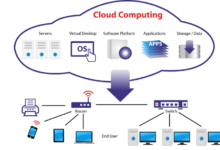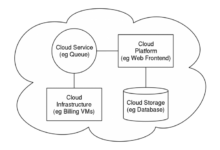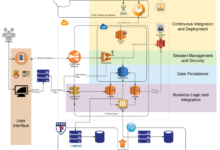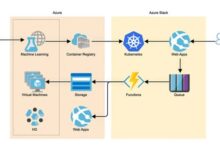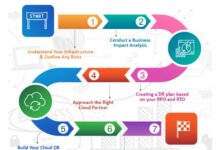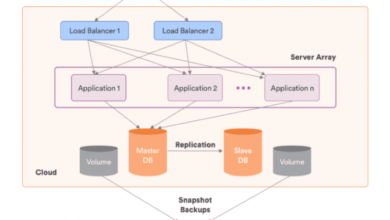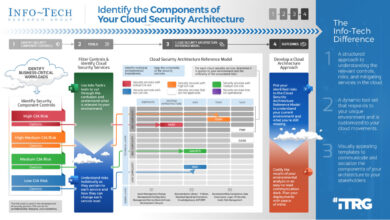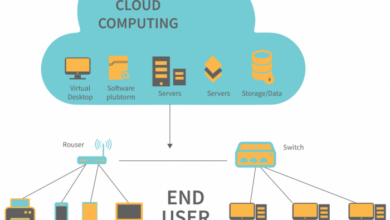How Cloud Architecture Diagrams Foster Agility: A Comprehensive Guide
In the realm of cloud computing, agility reigns supreme. Organizations strive to adapt swiftly to evolving market dynamics, customer demands, and technological advancements. Amidst this pursuit of agility, cloud architecture diagrams emerge as invaluable tools, empowering organizations to navigate the complexities of cloud infrastructure and services.
Cloud architecture diagrams serve as visual representations of cloud infrastructure, providing a comprehensive overview of its components, their interconnections, and their interactions. These diagrams play a pivotal role in enhancing agility by enabling organizations to identify potential bottlenecks, inefficiencies, and areas for improvement.
Moreover, they facilitate rapid changes and adaptations to cloud infrastructure and services, ensuring organizations remain responsive to changing business needs.
Overview of Cloud Architecture Diagrams
Cloud architecture diagrams are graphical representations that depict the components, relationships, and interactions within a cloud-based system. They serve as a valuable tool for visualizing and understanding the intricate architecture of cloud infrastructure and services. By providing a visual representation of the cloud environment, these diagrams facilitate effective communication, planning, and decision-making among stakeholders.
Agility and Cloud Architecture Diagrams

Cloud architecture diagrams play a pivotal role in fostering agility in cloud computing by providing a visual representation of the infrastructure, services, and their interdependencies. These diagrams enable organizations to identify potential bottlenecks and inefficiencies, facilitate rapid changes and adaptations, and ensure the cloud infrastructure aligns with business objectives.
Identifying and Addressing Bottlenecks and Inefficiencies
Cloud architecture diagrams help identify potential bottlenecks and inefficiencies in the cloud infrastructure by providing a comprehensive view of the system. By analyzing the diagram, organizations can pinpoint areas where resources are overutilized or underutilized, leading to performance issues or wasted resources.
This enables proactive measures to optimize resource allocation, improve performance, and reduce costs.
- Visualizing Resource Utilization: Cloud architecture diagrams allow organizations to visualize the utilization of resources such as CPU, memory, and network bandwidth. This helps identify resource-intensive applications or services that may require additional capacity or optimization.
- Analyzing Data Flow: By mapping the data flow between different components in the cloud architecture diagram, organizations can identify potential bottlenecks or inefficiencies in data transfer. This enables them to optimize data paths, reduce latency, and improve overall performance.
- Identifying Single Points of Failure: Cloud architecture diagrams help identify single points of failure, which are components or services whose failure can disrupt the entire system. By visualizing these dependencies, organizations can implement redundancy and fault tolerance measures to mitigate risks and ensure high availability.
Facilitating Rapid Changes and Adaptations
Cloud architecture diagrams facilitate rapid changes and adaptations to the cloud infrastructure and services. By providing a clear understanding of the system’s components and their interconnections, organizations can easily identify the areas that need modification or enhancement.
- Scalability and Elasticity: Cloud architecture diagrams help organizations plan for scalability and elasticity by visualizing how the system can be scaled up or down to meet changing demands. This enables them to make informed decisions about resource provisioning and ensure the infrastructure can accommodate future growth or fluctuations.
- Service Integration and Migration: Cloud architecture diagrams simplify the integration of new services or the migration of existing applications to the cloud. By mapping out the dependencies and interconnections, organizations can identify potential integration challenges and develop a structured migration plan, minimizing disruptions and ensuring a smooth transition.
- Continuous Improvement and Optimization: Cloud architecture diagrams enable continuous improvement and optimization of the cloud infrastructure. By regularly reviewing and updating the diagrams, organizations can identify areas for improvement, such as optimizing resource allocation, implementing cost-saving measures, or enhancing security. This iterative process helps organizations maintain a high-performing and efficient cloud environment.
Key Elements of Agile Cloud Architecture Diagrams
Agile cloud architecture diagrams are a visual representation of the essential components and relationships within a cloud-based system. These diagrams play a crucial role in supporting agility by providing a shared understanding of the architecture, enabling effective communication, and facilitating collaboration among stakeholders.
The key elements typically included in agile cloud architecture diagrams include:
Components
- Infrastructure: This includes physical resources such as servers, storage, and networking devices, as well as virtualized resources such as virtual machines and containers.
- Services: These are software components that provide specific functionalities, such as computing, storage, networking, and security.
- Applications: These are the software programs that end users interact with to perform their tasks.
Relationships
- Dependencies: These show the relationships between components, indicating which components rely on others to function properly.
- Data flows: These illustrate the movement of data between components, providing insights into the flow of information within the system.
- Security controls: These represent the measures put in place to protect the system from unauthorized access, data breaches, and other security threats.
Architectural Patterns
- Microservices: This involves decomposing an application into a collection of loosely coupled, independently deployable services.
- Containers: These are lightweight, portable environments that encapsulate an application and its dependencies, enabling easy deployment and scaling.
- Serverless computing: This allows developers to build and deploy applications without having to manage infrastructure or servers.
Significance of Key Elements
These key elements contribute to the overall effectiveness of cloud architecture diagrams in supporting agility in several ways:
- Clarity and Understanding: By visually representing the architecture, diagrams provide a clear and concise understanding of the system’s components, relationships, and architectural patterns.
- Communication and Collaboration: Diagrams facilitate effective communication and collaboration among stakeholders, including architects, developers, operations teams, and business leaders.
- Decision-Making: Diagrams help stakeholders make informed decisions about the design, implementation, and management of the cloud architecture.
- Agility and Adaptability: Diagrams enable organizations to adapt quickly to changing business requirements and technological advancements by providing a flexible and adaptable representation of the architecture.
Design Considerations for Agile Cloud Architecture Diagrams
Creating agile cloud architecture diagrams requires careful consideration of design principles and best practices to ensure they effectively communicate the dynamic nature of cloud environments. These diagrams should be clear, concise, and easily adaptable to changes in the cloud infrastructure.
Design Principles
- Simplicity: Diagrams should be simple and easy to understand, avoiding unnecessary details and clutter.
- Modularity: Design diagrams in a modular fashion, allowing for easy updates and additions as the cloud architecture evolves.
- Standardization: Use standardized symbols and notations to ensure consistency and clarity across diagrams.
- Abstraction: Focus on the essential elements of the cloud architecture, abstracting away unnecessary details.
Selecting Appropriate Tools and Techniques
- Diagramming Software: Use diagramming software or tools specifically designed for cloud architecture, offering features like symbol libraries and easy collaboration.
- Cloud-Native Tools: Consider cloud-native tools that integrate with cloud platforms, providing real-time updates and synchronization with the actual cloud environment.
- Collaborative Platforms: Utilize collaborative platforms that allow multiple stakeholders to contribute to and review diagrams, facilitating agile development.
Maintaining Up-to-Date Diagrams
- Regular Updates: Regularly update diagrams to reflect changes in the cloud architecture, ensuring they remain accurate and relevant.
- Version Control: Implement version control systems to track changes and maintain a history of diagram revisions.
- Stakeholder Communication: Communicate updates to stakeholders promptly, ensuring everyone has access to the latest version of the diagrams.
Collaboration and Communication with Cloud Architecture Diagrams
Cloud architecture diagrams play a crucial role in facilitating collaboration and communication among stakeholders involved in cloud adoption and migration initiatives. They serve as a common language that enables technical and business teams to align their objectives and work together effectively.
Aligning Technical and Business Objectives
Cloud architecture diagrams help align technical and business objectives by providing a visual representation of how the cloud architecture will support the organization’s goals. By visualizing the relationships between different cloud components, stakeholders can identify potential gaps or misalignments between technical capabilities and business requirements.
This facilitates discussions and decision-making, ensuring that the cloud architecture is designed to meet the organization’s strategic objectives.
Communicating Cloud Architecture Concepts to Non-Technical Stakeholders
Cloud architecture diagrams are an effective tool for communicating cloud architecture concepts to non-technical stakeholders, such as business leaders, decision-makers, and end-users. By using clear and concise visuals, diagrams simplify complex technical concepts, making them accessible to individuals who may not have a deep understanding of cloud technology.
This promotes a shared understanding of the cloud architecture, enabling stakeholders to provide valuable input and feedback during the design and implementation process.
Case Studies and Real-World Examples

Numerous organizations have successfully leveraged cloud architecture diagrams to enhance agility, leading to measurable improvements in their operations. Let’s explore a few notable case studies:
Amazon Web Services (AWS)
AWS, a leading cloud service provider, has extensively utilized cloud architecture diagrams to facilitate agile development and deployment processes. By visually representing their complex cloud infrastructure, AWS engineers can quickly identify potential bottlenecks, optimize resource allocation, and ensure high availability.
This proactive approach has enabled AWS to respond swiftly to changing market demands and customer requirements, maintaining its position as an industry leader.
Netflix
Netflix, a streaming entertainment giant, has employed cloud architecture diagrams to navigate the complexities of its global content delivery network. By creating detailed diagrams that map out the interdependencies between various cloud services, Netflix engineers can pinpoint performance issues, identify opportunities for optimization, and make informed decisions about scaling their infrastructure.
This systematic approach has allowed Netflix to deliver a seamless streaming experience to its vast user base, even during peak traffic periods.
Spotify
Spotify, a music streaming service, has harnessed the power of cloud architecture diagrams to streamline its continuous integration and continuous delivery (CI/CD) pipeline. By visualizing the workflow of their CI/CD processes, Spotify engineers can identify and resolve bottlenecks, ensuring rapid and reliable software deployments.
This agility has enabled Spotify to stay ahead of the competition by quickly introducing new features and enhancements to its platform, delighting its users with an exceptional music streaming experience.
Emerging Trends and Future Directions
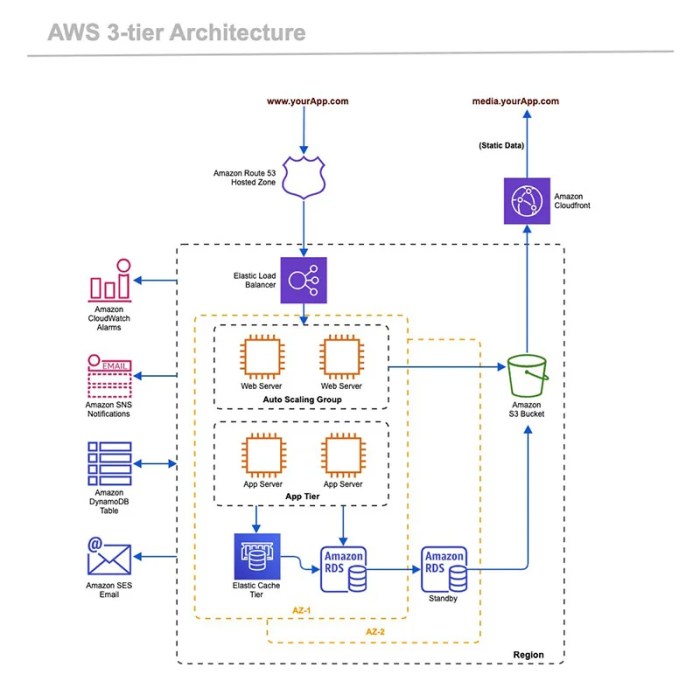
The realm of cloud architecture diagrams is witnessing a wave of innovation, with the emergence of cutting-edge tools and techniques that are transforming the way architects visualize and communicate cloud solutions.
These advancements are poised to redefine the future of cloud architecture diagrams, enhancing their ability to support agility and cater to the evolving needs of organizations.
AI-Powered Diagramming Tools
Artificial intelligence (AI) is making its mark on cloud architecture diagramming, enabling tools to automatically generate diagrams based on infrastructure configurations or code.
This capability streamlines the diagramming process, saving time and reducing the risk of errors, allowing architects to focus on higher-level design considerations.
Real-Time Collaboration and Version Control
Cloud-based diagramming tools are embracing real-time collaboration, enabling multiple architects and stakeholders to work on diagrams simultaneously.
Additionally, version control systems ensure that changes are tracked and managed effectively, facilitating seamless collaboration and ensuring the integrity of diagrams.
Integration with DevOps and Agile Tools
Cloud architecture diagrams are becoming increasingly integrated with DevOps and Agile tools, enabling seamless synchronization between architectural designs and development processes.
This integration facilitates continuous feedback loops, allowing architects to quickly adapt diagrams based on changes in requirements or infrastructure.
Interactive and Dynamic Diagrams
The future of cloud architecture diagrams lies in interactivity and dynamism.
Diagrams are evolving to include clickable elements, allowing users to drill down into specific components or services for more detailed information.
Additionally, dynamic diagrams can automatically update based on real-time data, providing a live view of the cloud infrastructure.
Security and Compliance Considerations
As cloud adoption continues to grow, security and compliance concerns are becoming increasingly important.
Cloud architecture diagrams can play a crucial role in ensuring that cloud solutions adhere to regulatory requirements and industry best practices.
Diagramming tools are incorporating features that assist architects in visualizing and analyzing security controls and compliance measures.
Outcome Summary
In conclusion, cloud architecture diagrams are indispensable tools for organizations seeking to foster agility in cloud computing. By providing a visual representation of cloud infrastructure and services, these diagrams enable organizations to identify potential bottlenecks, facilitate rapid changes, and align technical and business objectives.
Moreover, they promote collaboration and communication among stakeholders, ensuring a shared understanding of cloud architecture concepts. As cloud architecture continues to evolve, organizations must embrace the use of cloud architecture diagrams to remain competitive and thrive in the digital age.
